New
BFCM Offer!!! Get a FREE intent analysis for every visitor/traffic to your Shopify store. 🚀
Install now
Book a demoClose Modal×
Thank you! Your submission has been received!
Oops! Something went wrong while submitting the form.
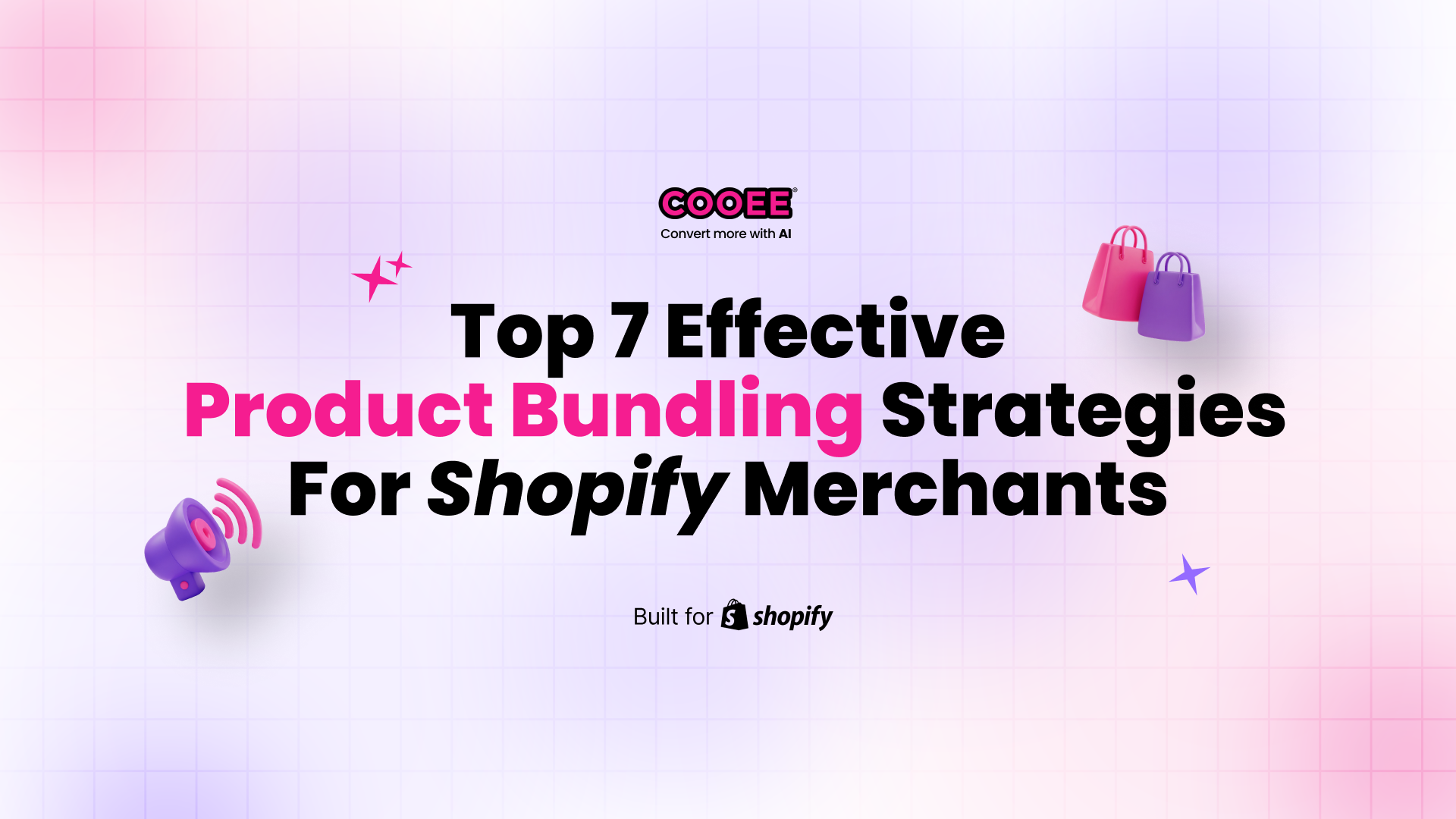
There’s no one-size-fits-all when it comes to Shopify product bundling. The right approach depends on your products, your customers, and your sales goals.
This section will cover 7 proven product bundling strategies you can try in your Shopify store, including discounted bundles, mix-and-match sets, custom bundle builders, volume-based offers, frequently bought together suggestions, seasonal packs, and subscription-based bundles.
A discounted bundle is a group of complementary products sold together at a lower price than if each item were purchased separately. It typically appears on your Shopify store as a dedicated “Bundle and Save” section, a widget on product pages, or a pop-up in the cart, clearly showing the original total price crossed out alongside the new discounted price.
Instead of just grouping products at random, focus on pairing items that naturally go well together, like a shampoo and conditioner, or a mug with a bag of coffee.
This approach gives shoppers a clear reason to add more to their cart and helps you move inventory faster.
To make your discounted bundles stand out, try these practical tips:
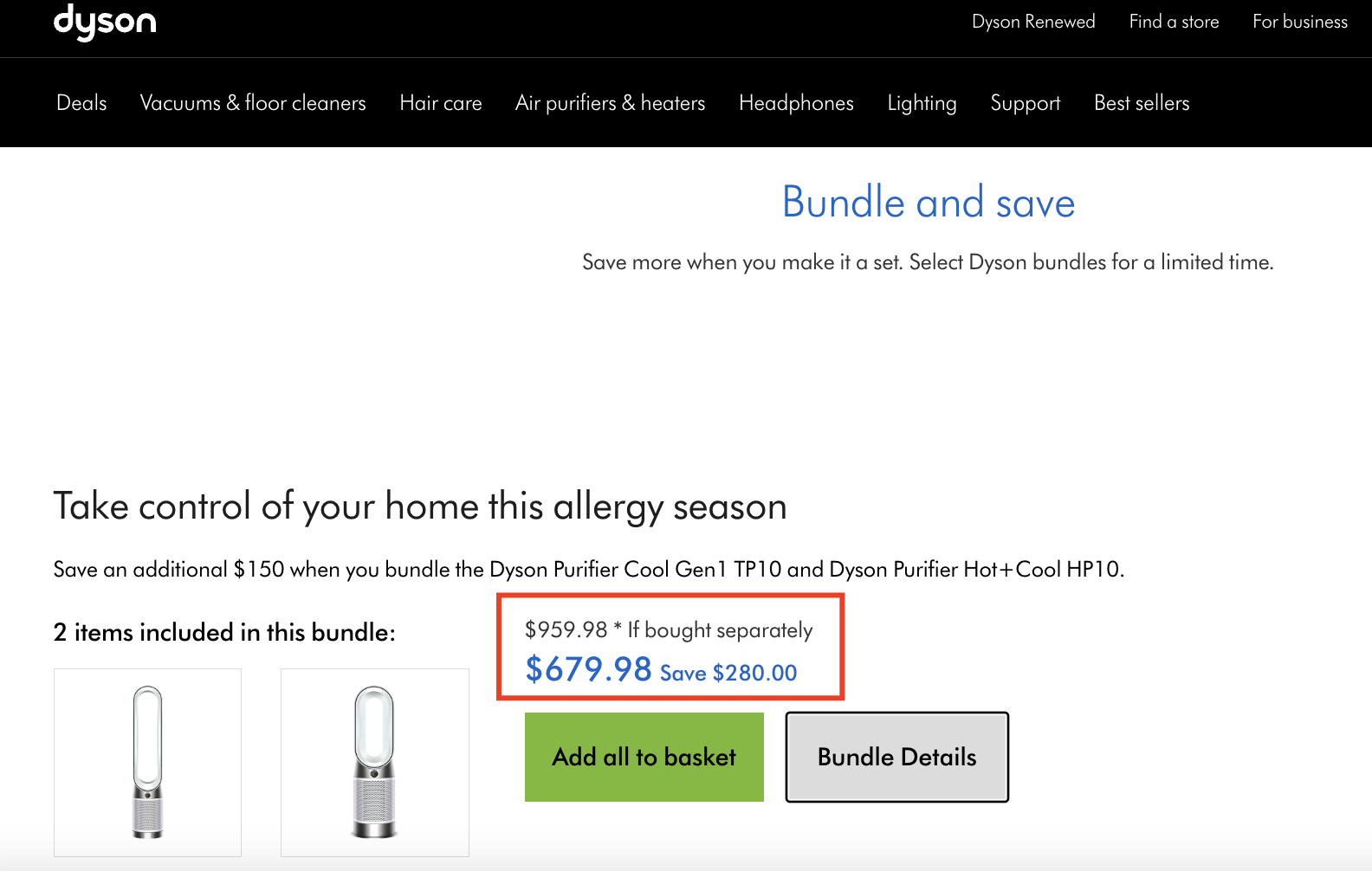
Limited-time Dyson set with bundled discount.
To keep bundles fresh and engaging, rotate your combinations every few weeks or months. This gives returning shoppers something new to consider and helps avoid “banner blindness.”
And remember, a little A/B testing goes a long way — experiment with different discount levels to find the sweet spot that boosts sales without cutting too much into your margins.
Mix and Match is one of the most flexible product bundling strategies that gives shoppers the power to personalize their purchase. This approach allows customers to select a specific number of items from a broader set — for example, “Pick any 3 out of 10 products.”
It works especially well with customizable items like colors, flavors, scents, or sizes, and creates a sense of ownership and engagement in the shopping experience.
On Shopify, Mix & Match bundles typically appear as interactive bundle builders on product or collection pages, pop-ups with toggling options, or modules that include real-time progress indicators like “You’ve selected 2 of 3 items.” For customers who prefer not to customize, stores often offer predefined templates for quick add-to-cart convenience.
There are two common forms of this strategy:
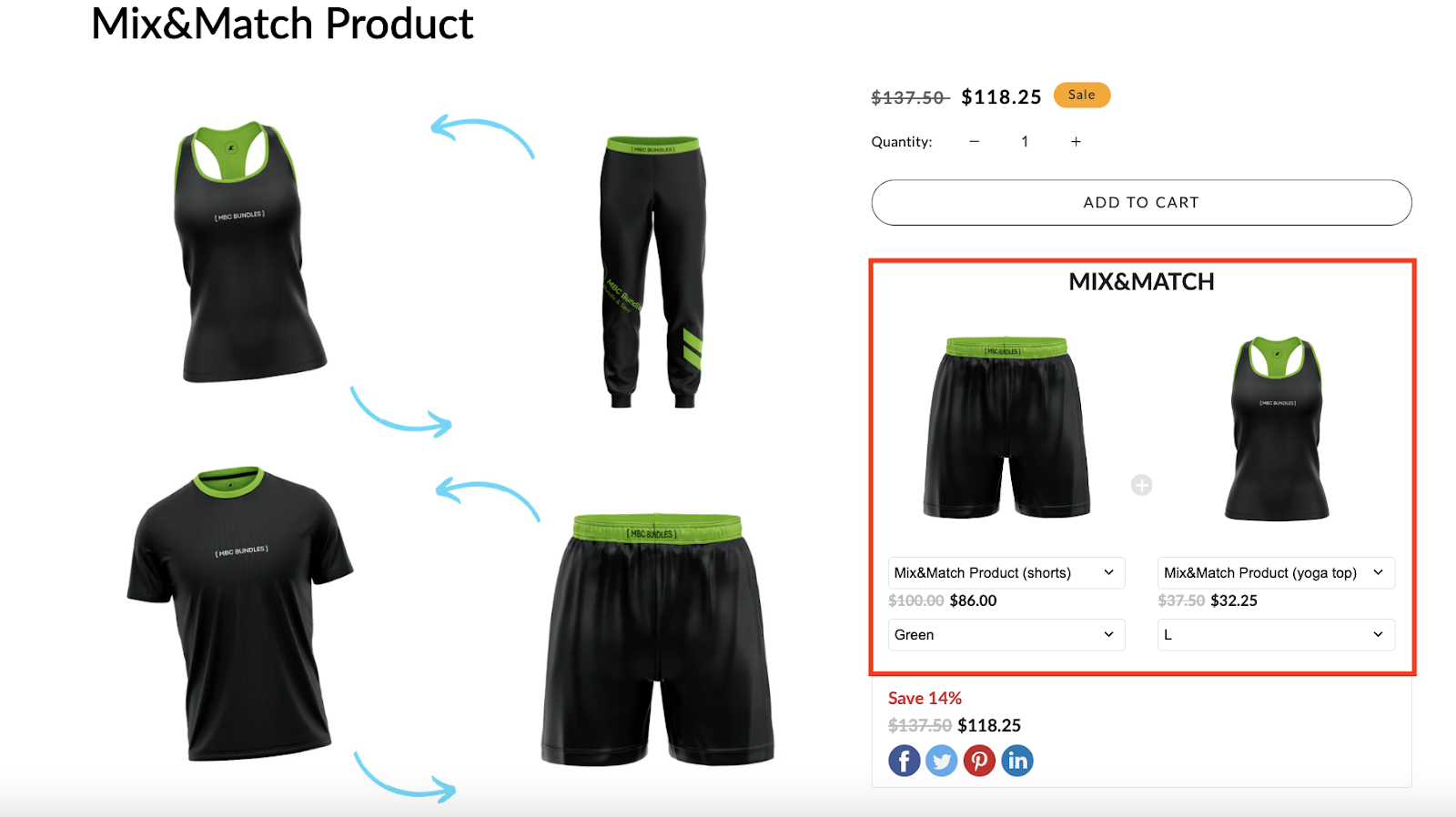
Shoppers select individual items from a curated product list.
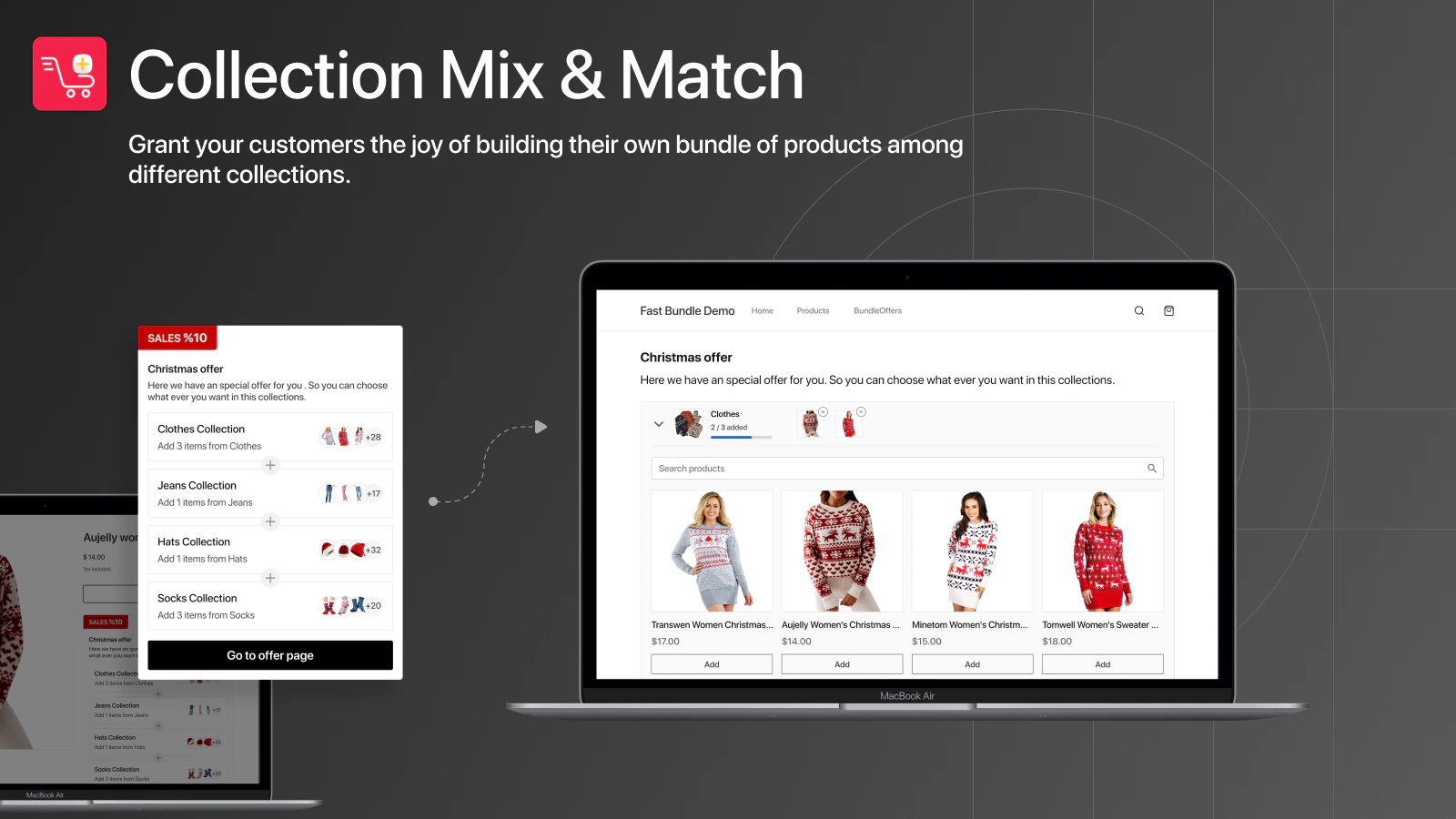
Customers build bundles by choosing items from multiple collections.
To implement this effectively:
Another great touch is to balance freedom with convenience. While some customers enjoy building their own bundles, others prefer ready-made options.
Create curated templates — pre-selected sets they can grab and go — alongside the mix and match option, so everyone finds a path that suits them. This strategy shines in use cases like DIY snack boxes, skincare regimens, outfit creators, or tea samplers, where personalization is key.
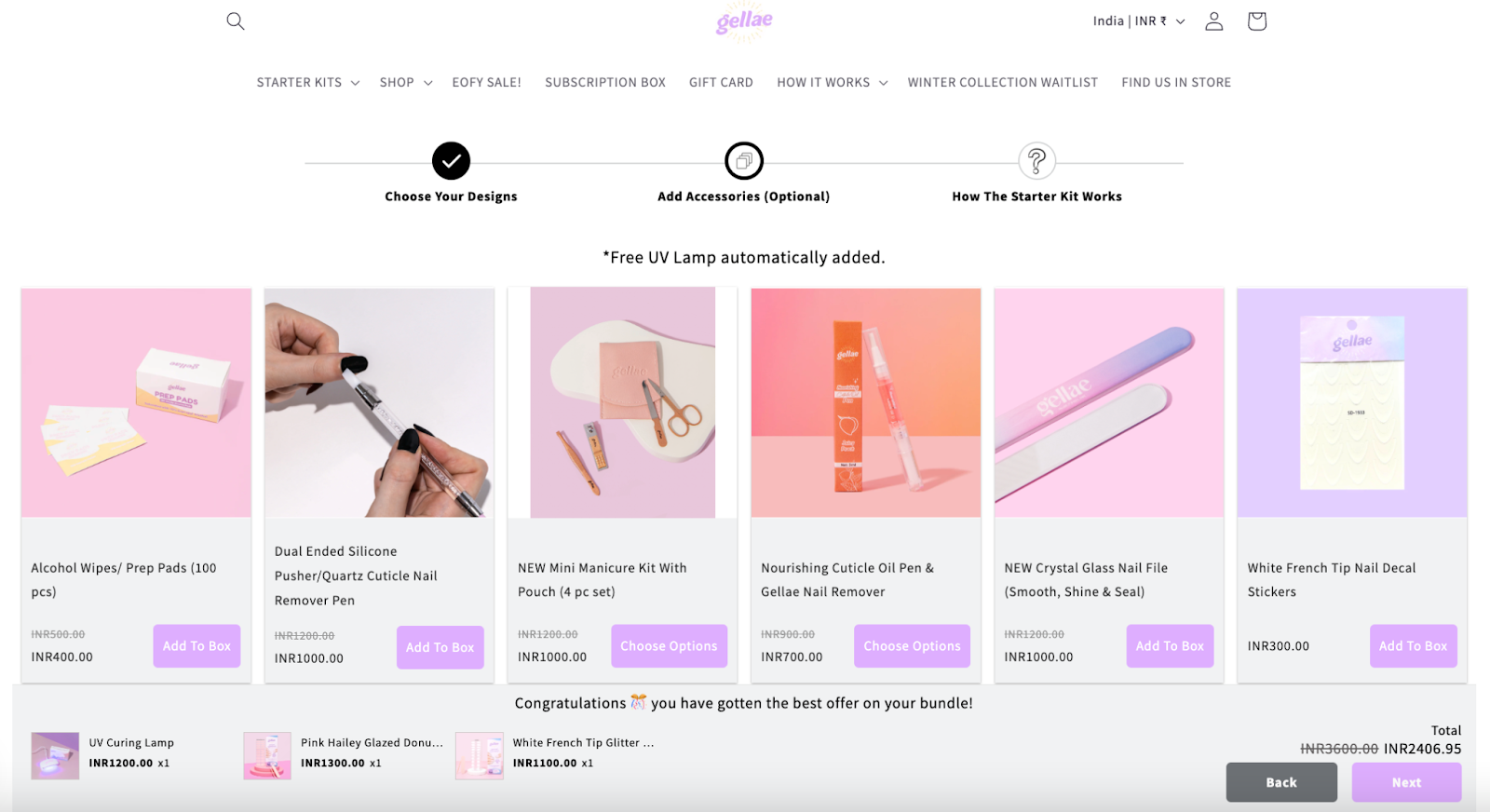
Curated nail kit builder with guided bundle steps.
A Bundle Builder Page is a dedicated landing page on your Shopify store designed specifically to showcase product bundles, separate from your main product pages.
Structurally, it typically includes a clear title (e.g., “Build Your Bundle”), visually appealing images or banners, a selection area for bundle components, and a streamlined checkout flow.
It often appears as a standalone page linked from your store’s navigation menu, homepage, or promotional emails, and is commonly used for special campaigns, themed collections, or personalized offers like “Starter Kits” or “Gift Sets”.
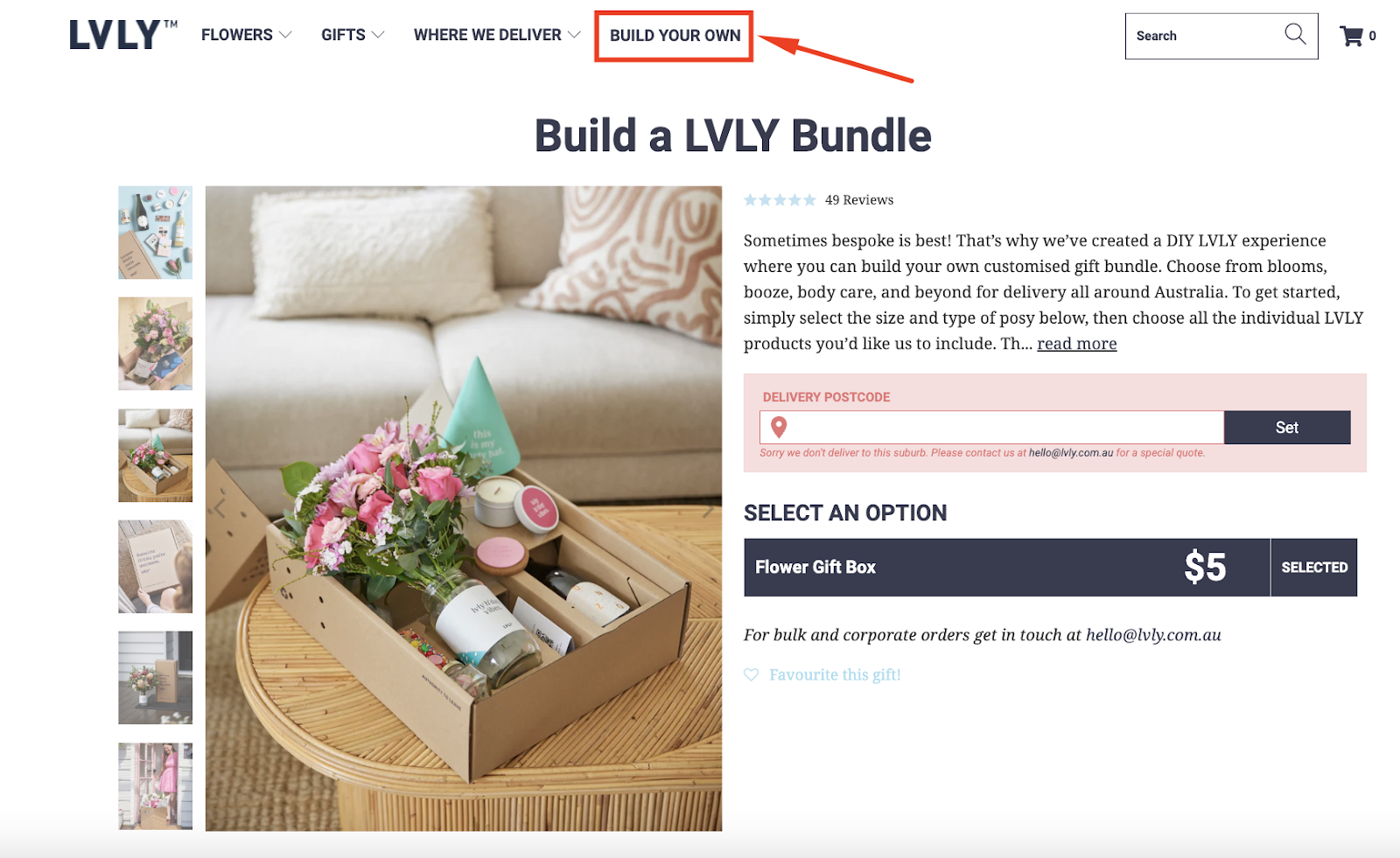
LVLY – Bundle Builder Landing Page
For Shopify merchants, here’s how to make it effective, along with key insights you should know:
Additionally, leverage dynamic bundle generation based on tagged collections to keep the page automatically updated with relevant products.
Add social proof, such as “X people started their journey with this bundle last week,” to build trust and encourage purchases. A sticky cart summary is also crucial — it lets customers track their selections in real-time, preventing confusion.
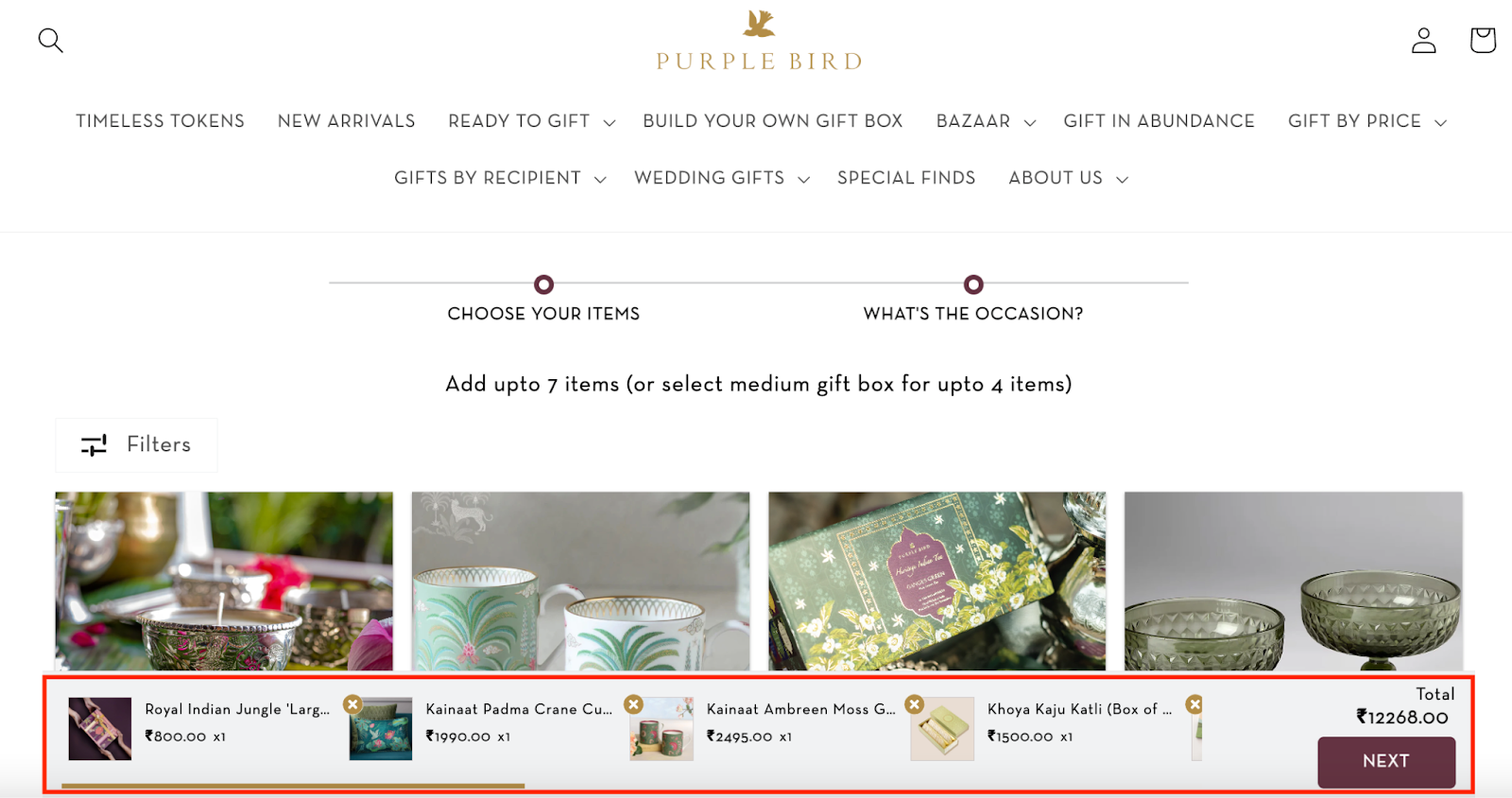
Purple Bird – Sticky Cart Summary View
For technical setup, integrate the page into your store’s navigation for easy access, and customize the layout via Shopify’s theme editor to match your brand’s look.
Volume discount bundles are one of the most straightforward yet effective product bundling strategies on Shopify.
The idea is simple: the more a customer buys, the more they save. It’s ideal for fast-moving or repeat-use products (e.g, skincare refills, snacks, coffee pods, vitamins, or pet food). These bundles encourage customers to stock up, boosting average order value while still offering perceived value.
This type of bundle usually appears directly on the product page as a widget or table, showing different quantity options with corresponding discounts. For example:
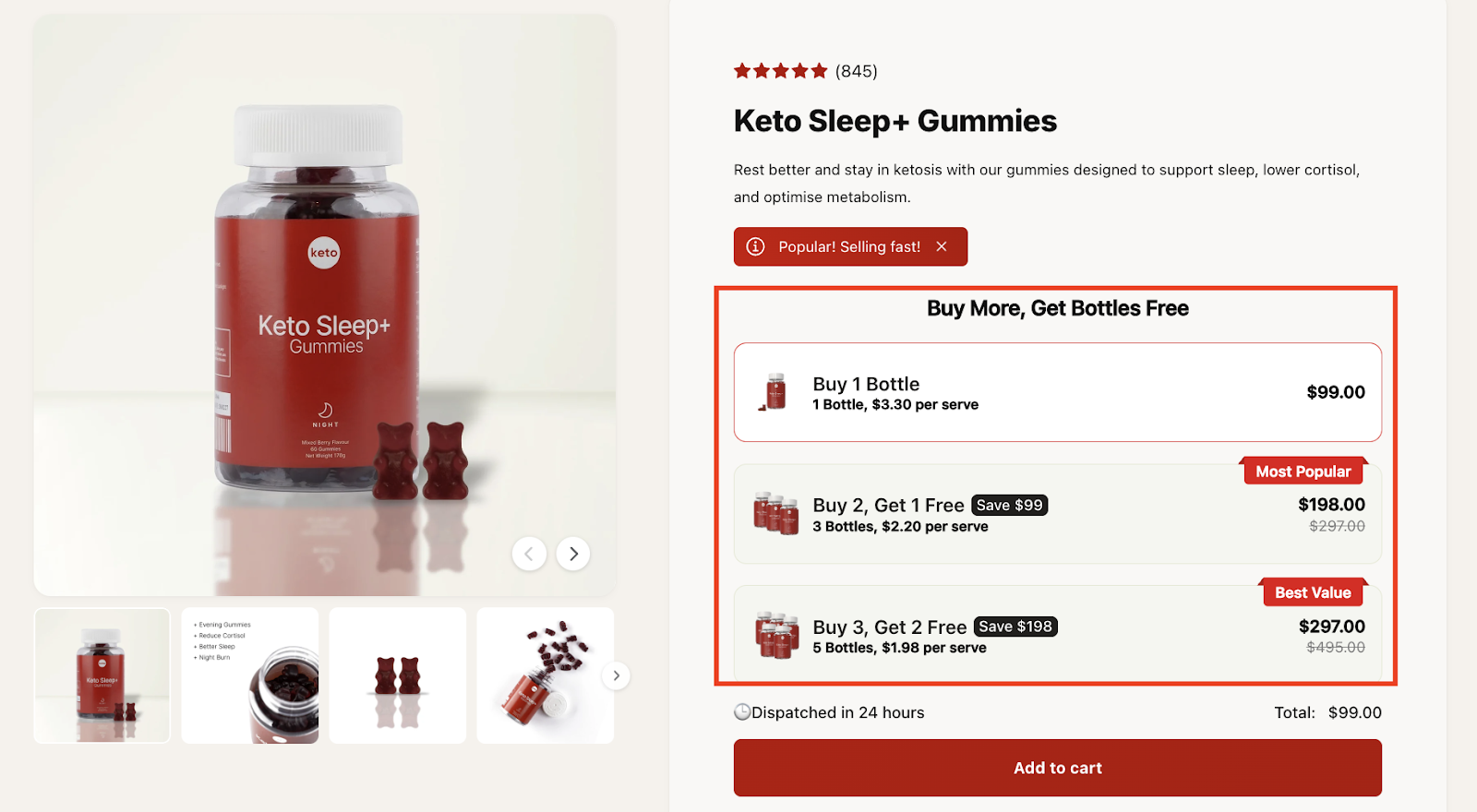
Volume bundle with tiered pricing and badges
The layout might include:
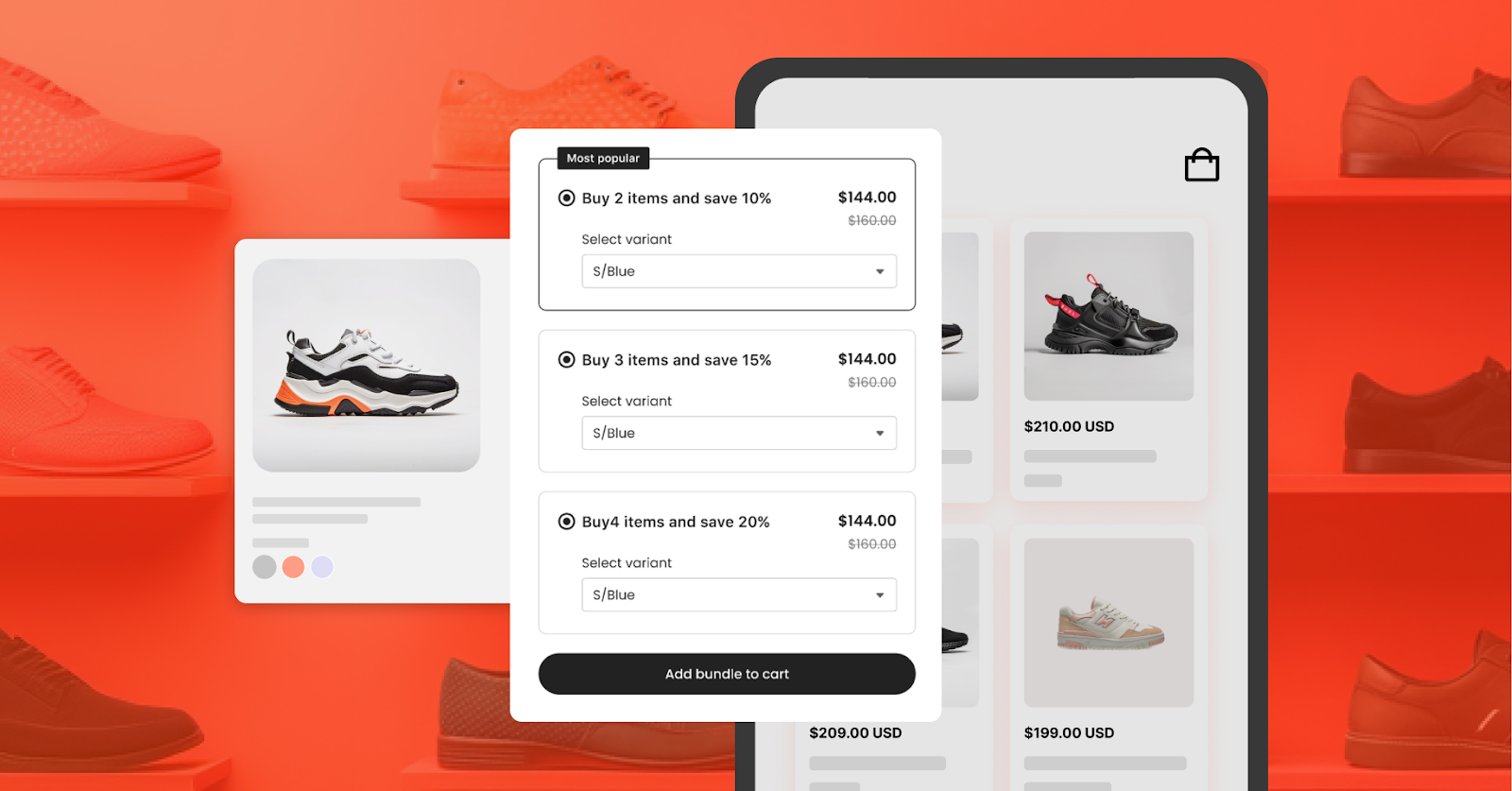
Auto-updating volume discount widget for variants (Source: Boost Commerce)
Here’s how Shopify merchants typically make this strategy work:
You can tie volume discounts to memberships or loyalty programs. For example, only logged-in members get access to the best pricing tiers, making customers feel rewarded and more likely to join.
This strategy is clean, scalable, and fits naturally into most product pages. When done right, volume discount bundles strike the perfect balance between customer savings and higher revenue per order, making it a must-have in your Shopify product bundling strategies toolkit.
Frequently Bought Together (FBT) is a smart and proven Shopify product bundling tactic that suggests complementary products based on real customer behavior.
You’ve probably seen it under other names, too, like “Complete the Look,” “Customers Also Bought,” or “You Might Like These.” The format may vary, but the core idea stays the same: recommend relevant add-ons based on real customer behavior.
It uses order history, cart activity, and buying patterns to recommend combinations that shoppers often purchase together, like a camera with an SD card and protective case, or a yoga mat with a towel and carrying strap.
This strategy commonly appears as a bundle widget on:
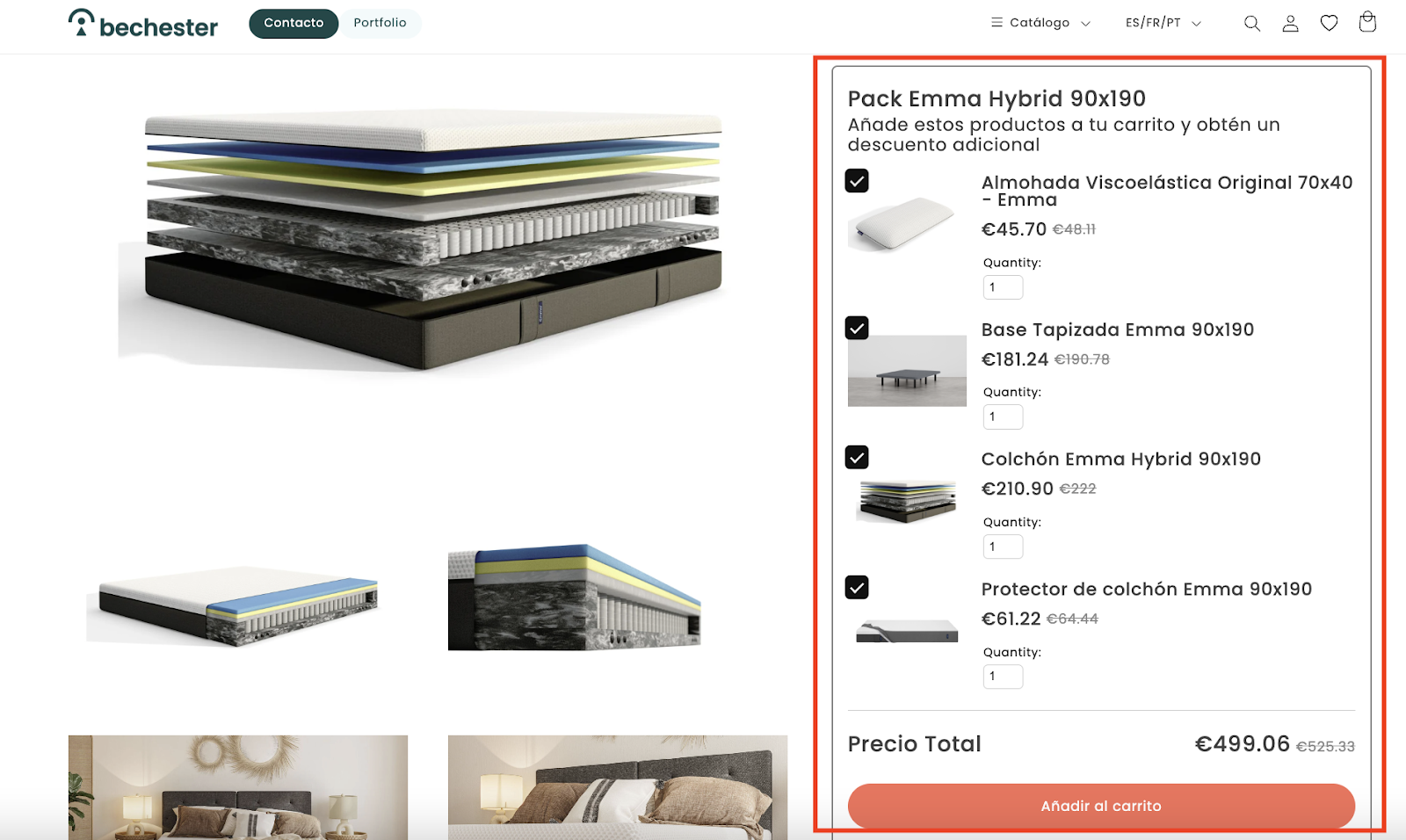
Frequently Bought Together on product page widget

“You may also like” bundle in cart preview
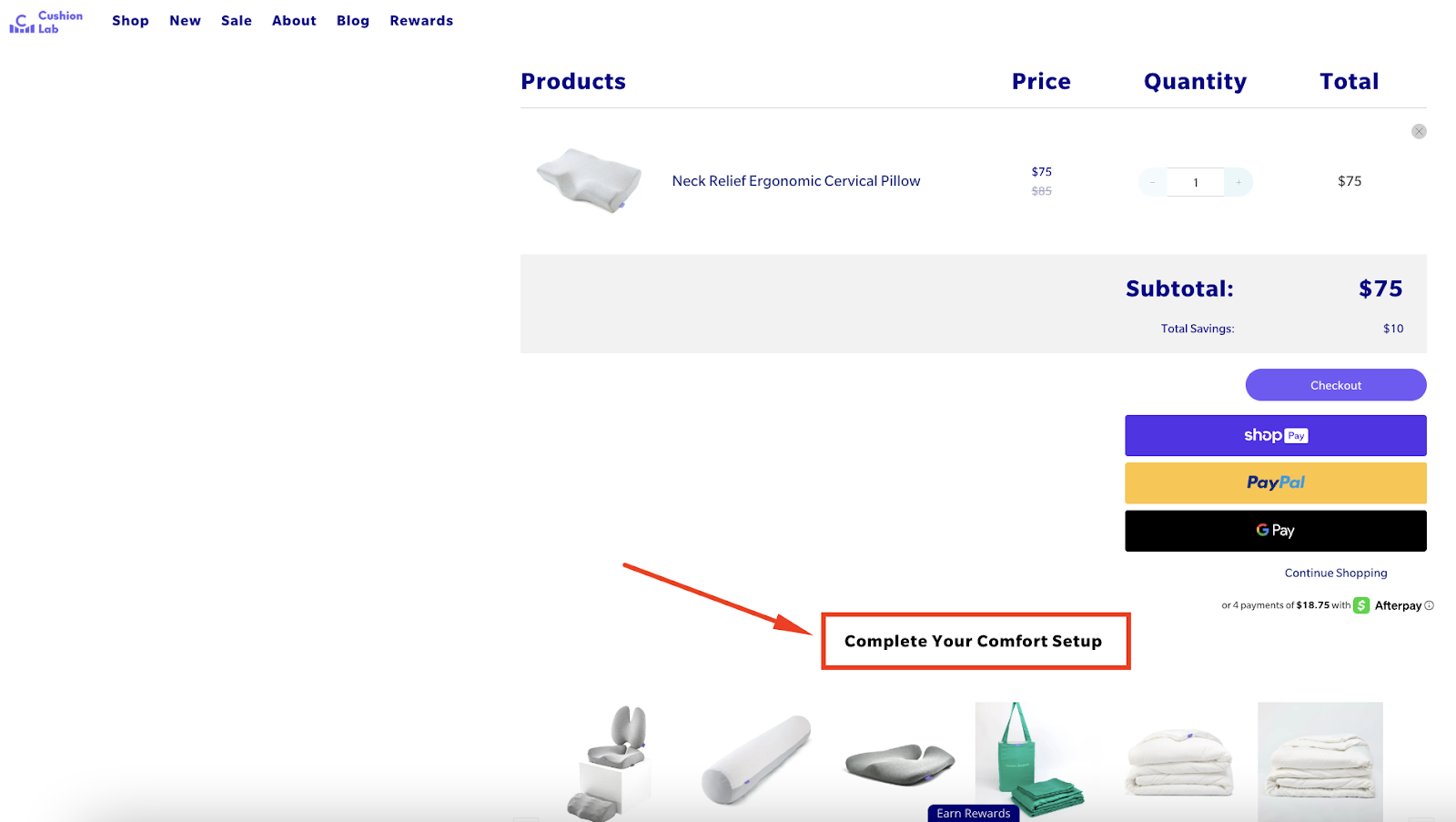
Quick-add bundle offer at the checkout stage
The goal is to increase average order value without interrupting the customer’s flow. The best-performing bundles feel natural, useful, and timely, not random. That’s why logic matters: irrelevant combinations (e.g., “dog leash + wine opener”) hurt trust and conversion.
Here’s how to do it well:
What makes it advanced:
Some products sell year-round. Others spike during specific moments, such as holidays, weather shifts, or cultural events. That’s where seasonal bundling becomes powerful.
You group timely products into a themed set, give it a clear purpose (e.g, gifting, travel, celebration), and create urgency with limited availability.
Here are 5 types of seasonal bundles merchants often use:
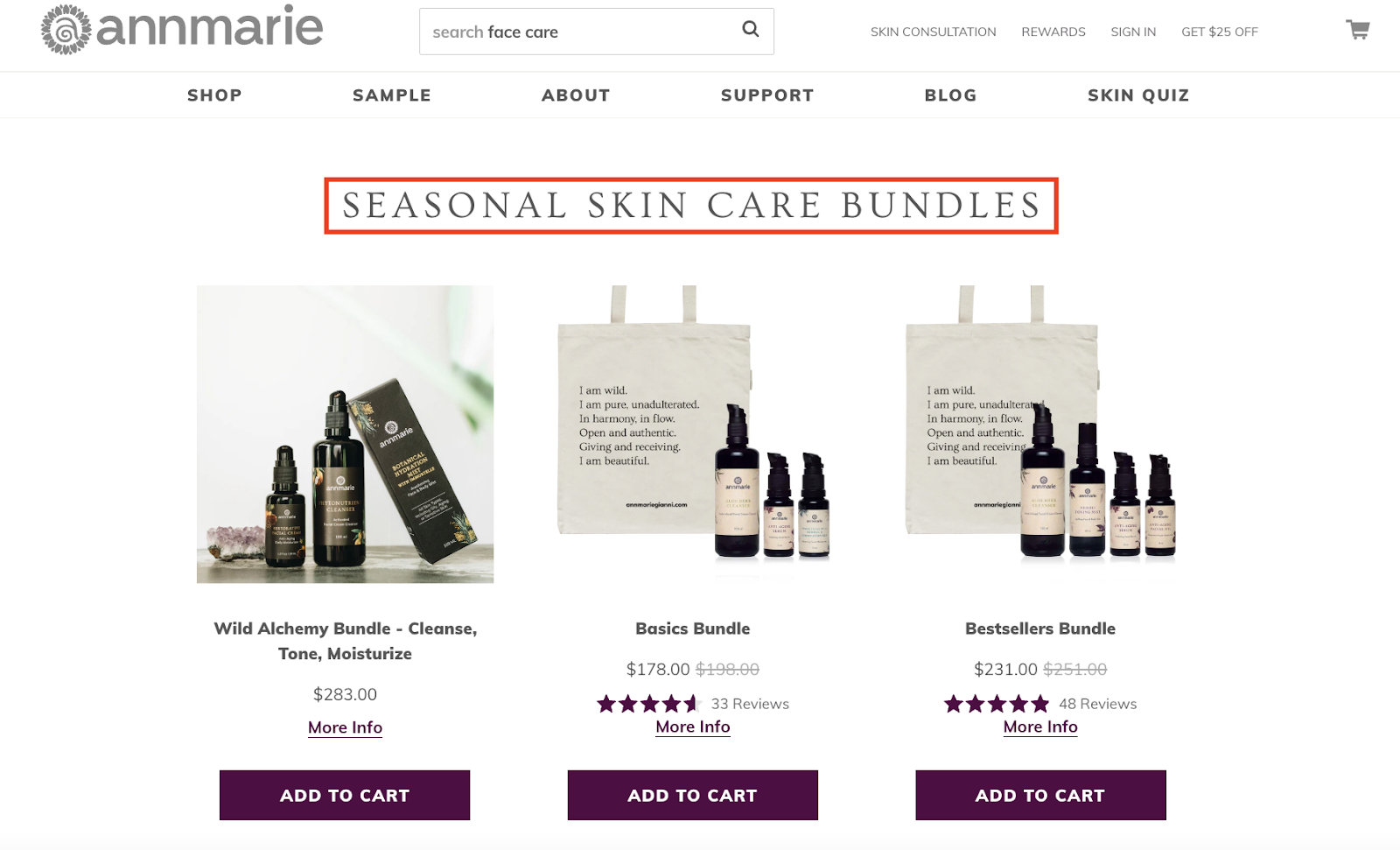
Annmarie’s seasonal bundles
To make seasonal bundling work, it’s best to launch offers early, well before the peak, and use countdowns or limited-stock alerts to drive urgency. At the same time, reuse your existing inventory. Group products by season, color, or function to create fresh combinations without new SKUs.
If you’re not aware, retailers in North America lost over $349 billion in 2022 due to issues with out-of-stock and overstocked items. That’s why smart product bundling strategies can help move seasonal items faster and avoid those losses.
To support this, consider two simple inventory methods:
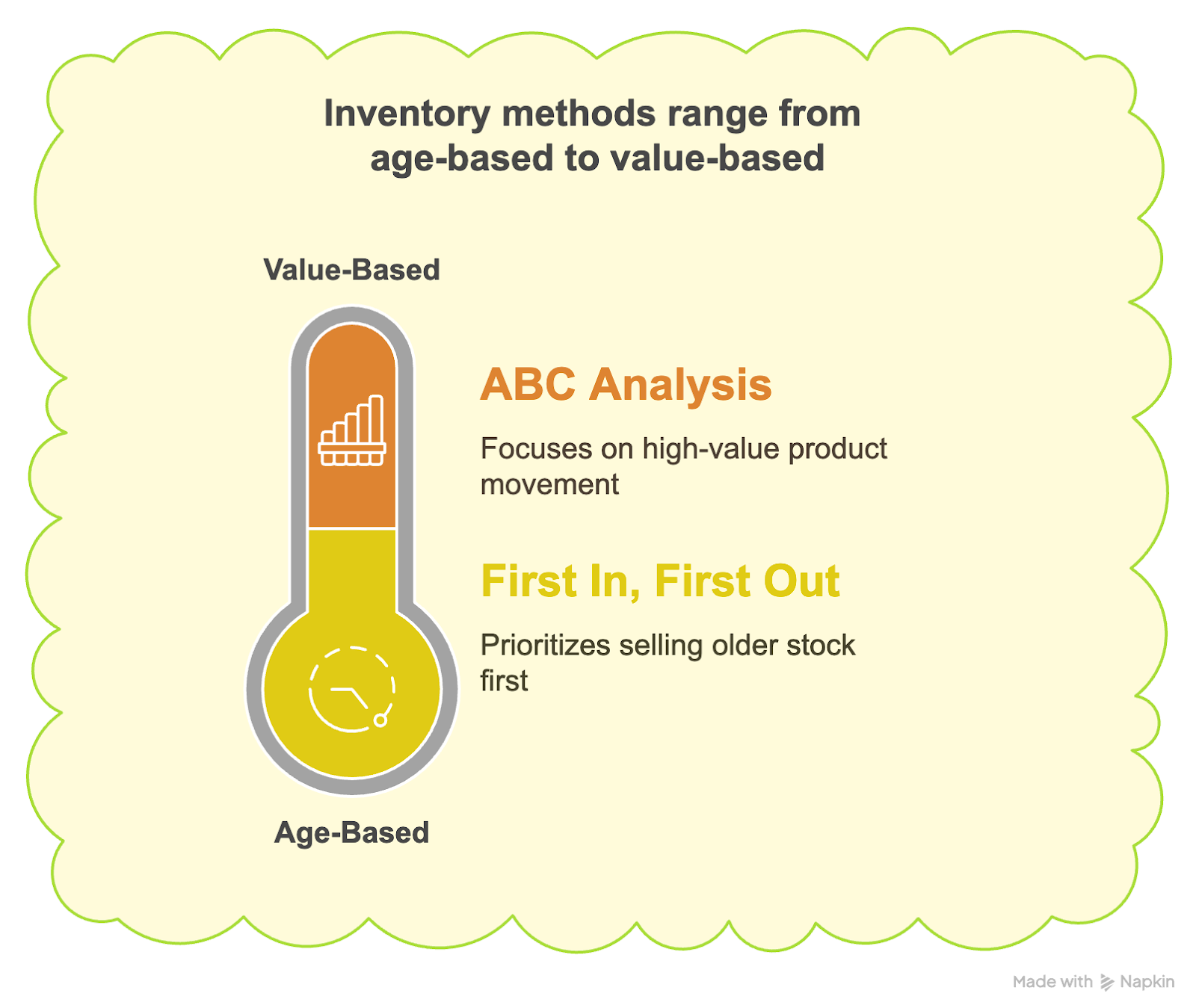
A few notes to keep in mind:
When done properly, seasonal bundling is not only relevant but also one of the most reliable product bundling strategies for increasing conversions, freeing up shelves, and aligning your store's offerings with what buyers already desire.
Subscription-based bundling is when you group products into a set that ships on a regular schedule — monthly, every 2 months, or seasonally. It’s one of the most effective Shopify product bundling models for building steadily.
You’ve probably seen this in beauty boxes, coffee clubs, or supplement kits. Customers pay upfront (or per cycle) and get a curated package at their doorstep. No repeat checkout needed.
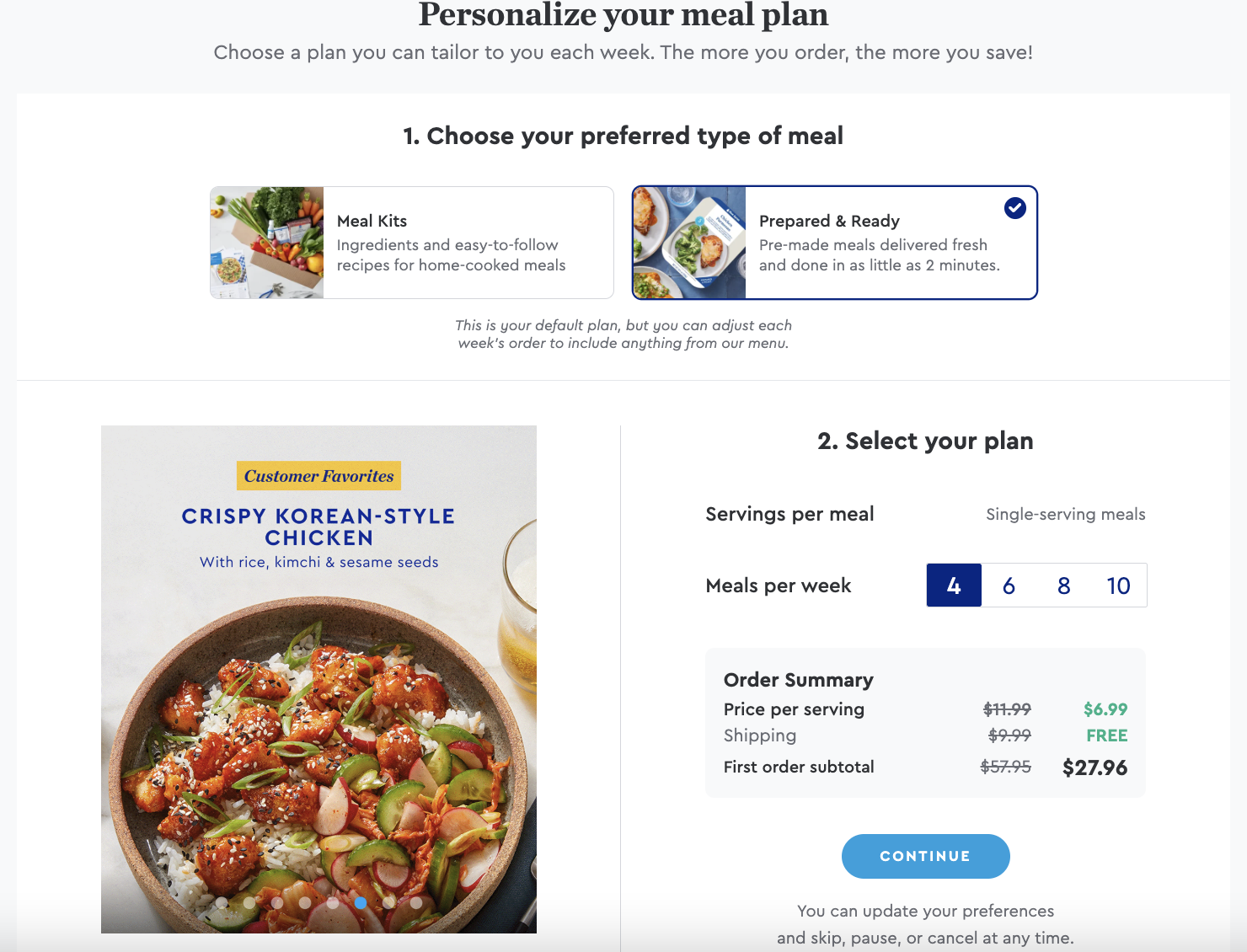
Personalized subscription bundle for weekly meal kits
Unlike standard bundles, which are often used to increase the size of a single order (e.g., “Buy 2, Get 1 Free”), subscription-based bundling is about building an ongoing relationship. Customers aren’t just buying once; they’re signing up to receive products regularly.
According to a 2025 study published in IRJMETS, 74% of users switched from individual subscriptions to bundled ones in the past year, mainly due to convenience and cost savings. And over 62% said they’re very likely to keep using those bundles long term, proving it’s not just a short-term gimmick.
To make it work on your Shopify store:
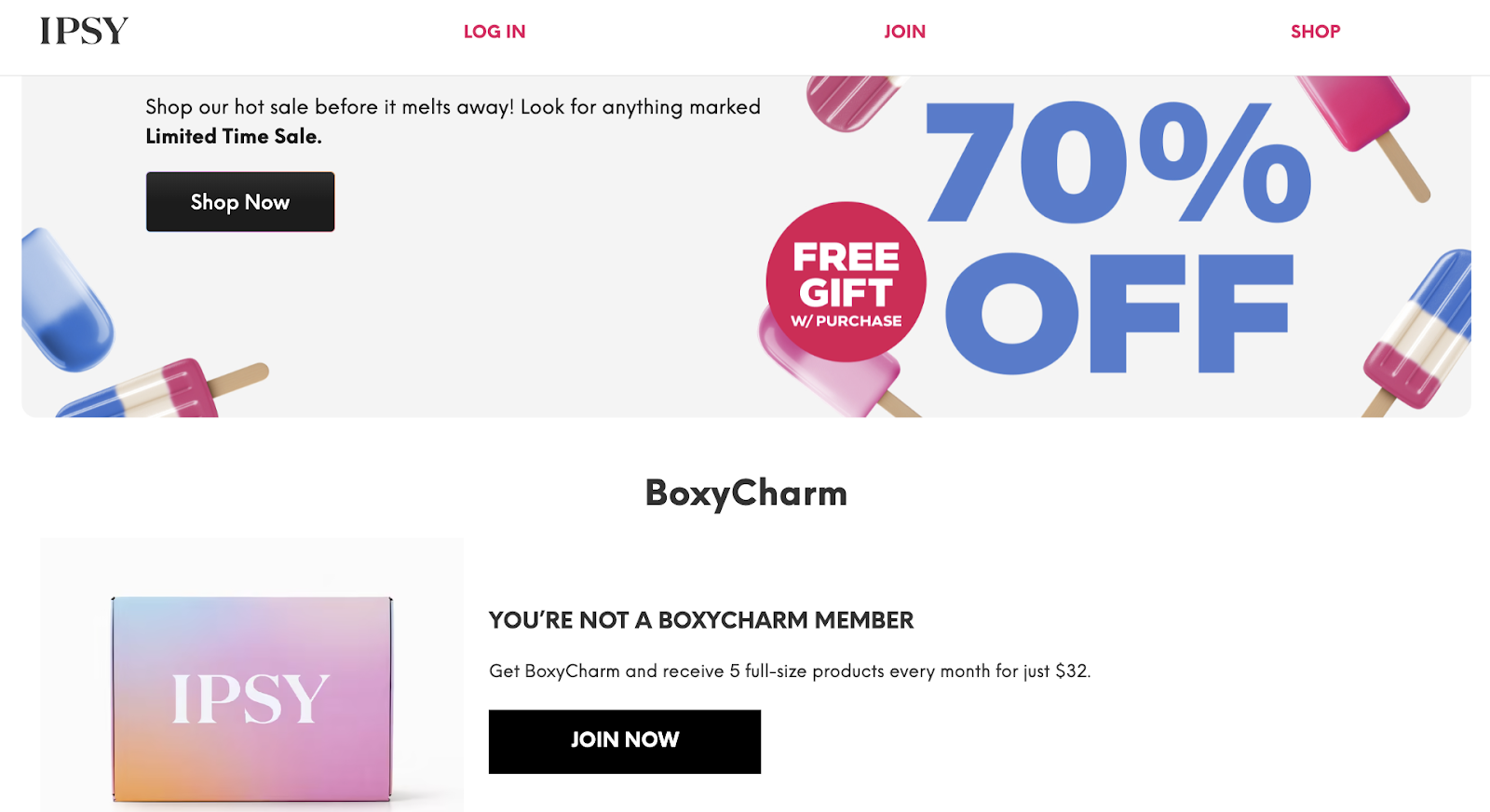
Subscription box promo with discount and free gift offer
This form of Shopify product bundling works especially well for stores selling replenishable goods. Just don’t forget the flexibility. Forcing rigid plans is the fastest way to get canceled.
While you can use the Shopify Bundles app (by Shopify) to create simple product bundles, many merchants find it unreliable. The app has strict limitations and frequent inventory glitches. If you’re serious about Shopify product bundling, consider one of the more powerful and stable apps below.
BOGOS.io is one of the most versatile Shopify product bundling apps out there. While it’s known for BOGO and free gift offers, its real strength lies in bundling, especially for merchants who want flexibility, automation, and native Shopify compatibility.
With a 4.9⭐ rating from 2,200+ reviews, it has been battle-tested by thousands of stores across various industries.
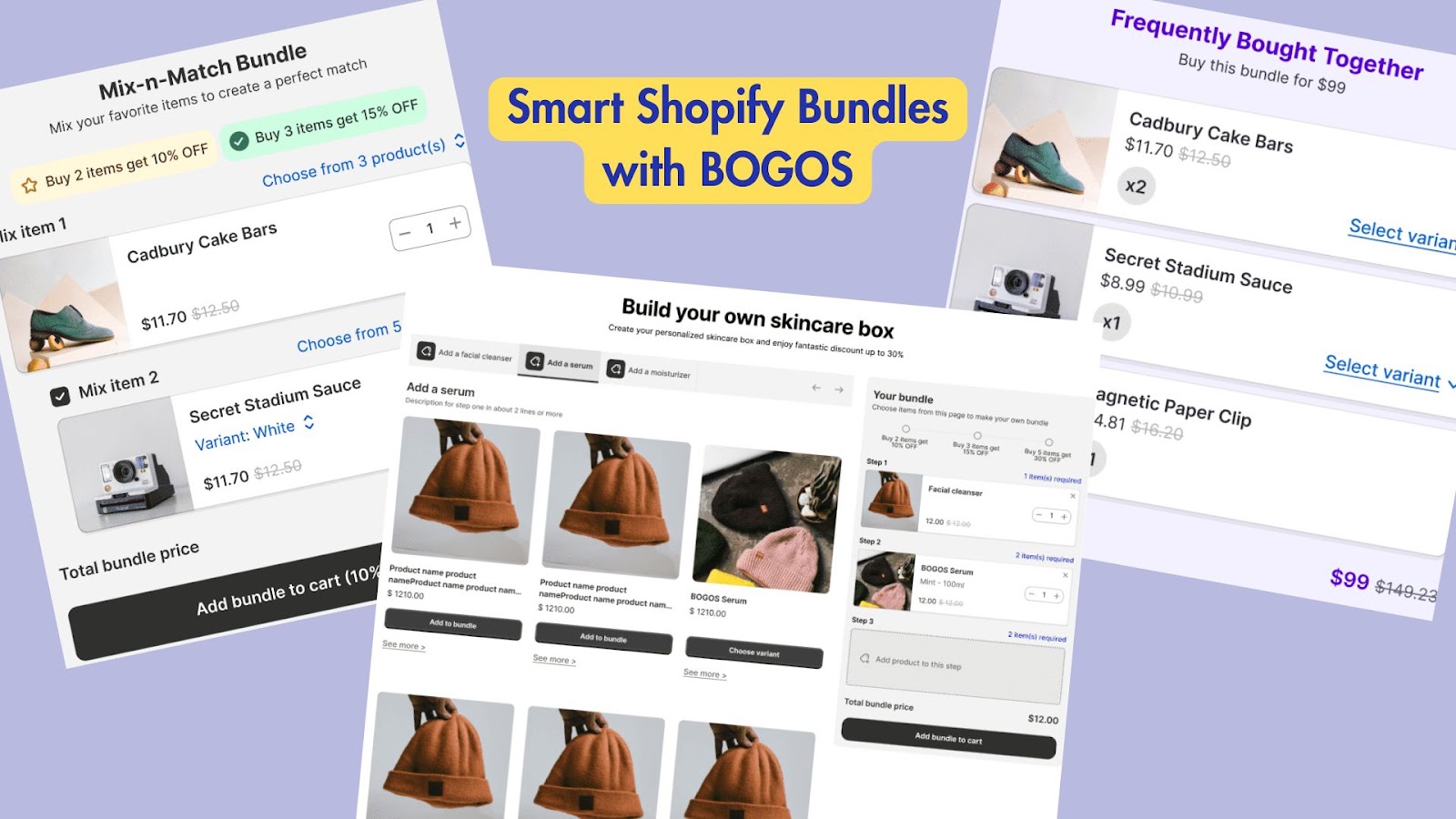
You can create 3 powerful types of product bundles with BOGOS:
Pricing Plans (all include unlimited offers & 7-day free trial)
Use this app if you want maximum control over bundling logic, free gift promos, and seamless Shopify integration. All is in one place. Ideal for stores running frequent bundle offers across multiple channels.
Cooee is a behavior-based engagement engine that helps Shopify stores deliver the right message or offer at the right time. With a perfect 5.0⭐ from 40+ reviews, it’s known for converting traffic using AI-driven popups, widgets, and bundle offers that adapt to each visitor’s intent in real time.
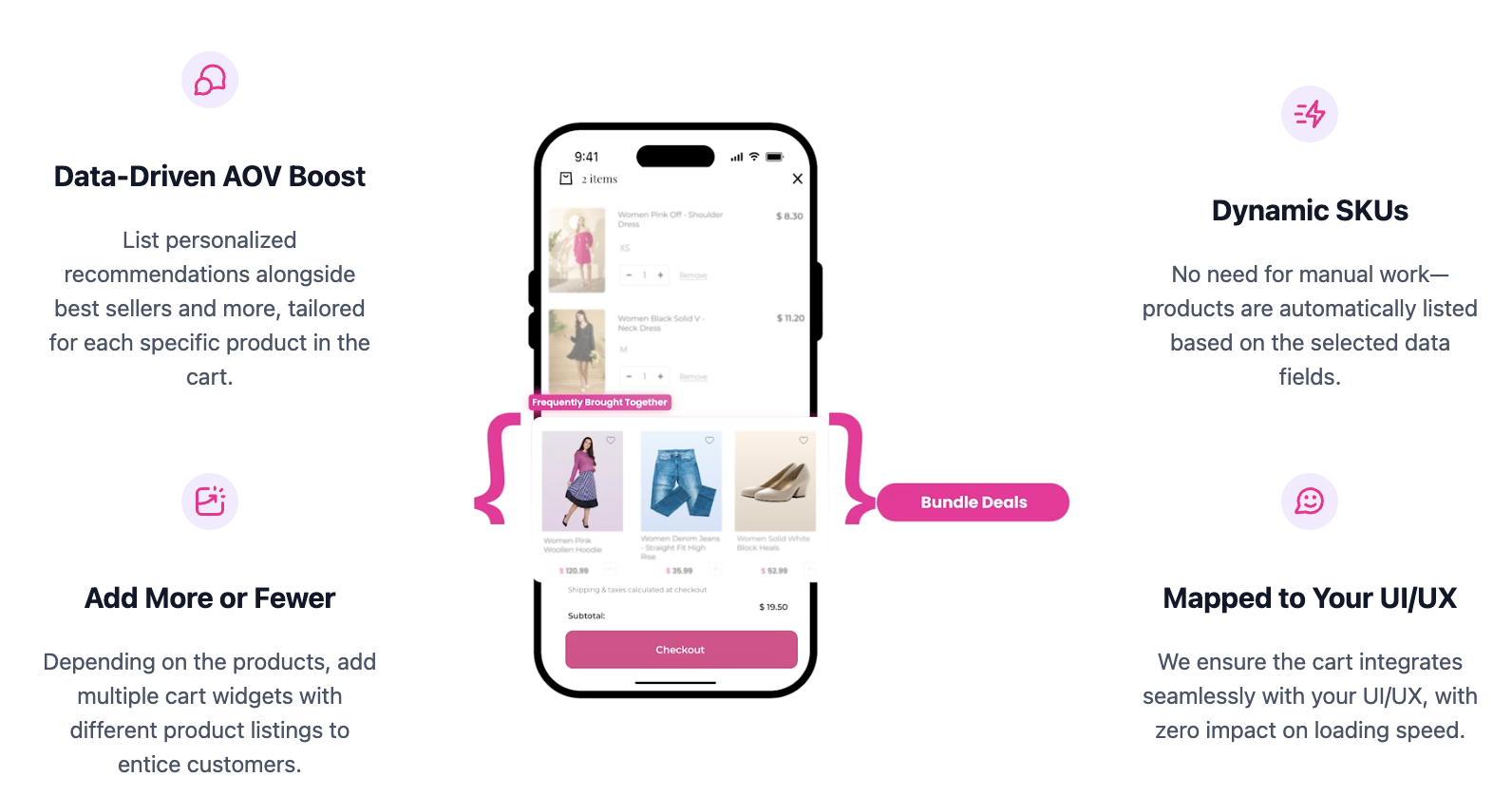
Key Features for Bundling
Pricing Plans
This app is best for stores that want to personalize every popup and bundle offer in real time, based on customer intent.
If you're after a straightforward Shopify product bundling tool that also packs in volume discounts and free gift offers, Pumper Bundles is a solid bet. With 5⭐ and 1,600+ reviews, it’s trusted by thousands of merchants for its ability to turn simple product groups into profit machines.
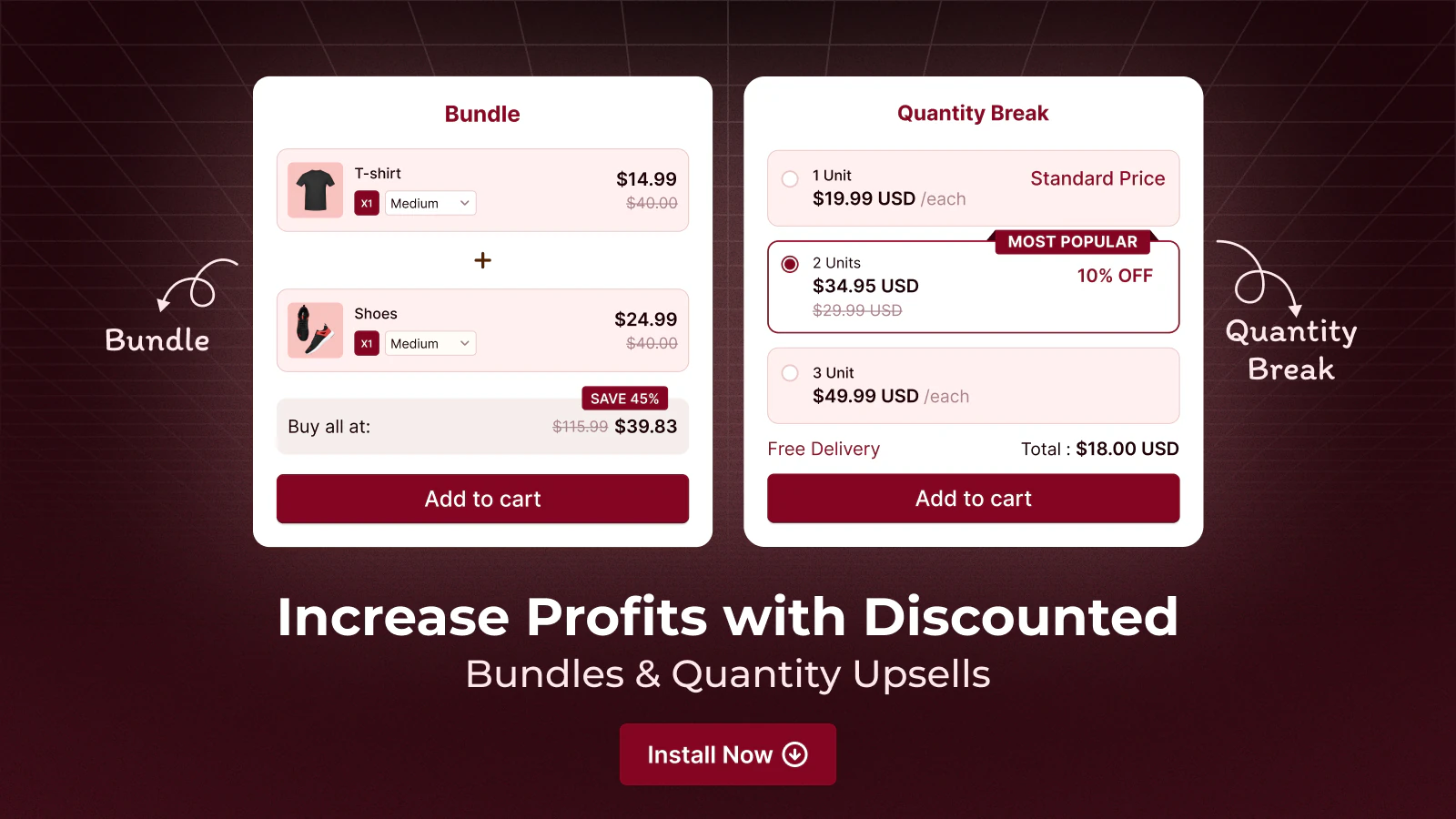
Key Features
Pricing Plans
Each paid plan includes unlimited bundles, chat support, and a 14-day free trial.
This app is ideal for merchants who value simplicity and performance without sacrificing customization.
Fast Bundle (FBP) lives up to its name. It’s built for merchants who want speed, flexibility, and control. Whether you’re offering Mix & Match, BOGO, Volume Discounts, or a custom bundle builder page, this app has it all — and it works smoothly inside Shopify Admin.
With 4.9⭐ and 1,300+ reviews as well as multi-language support, it’s a go-to choice for global stores that want serious bundling power without complex setup.
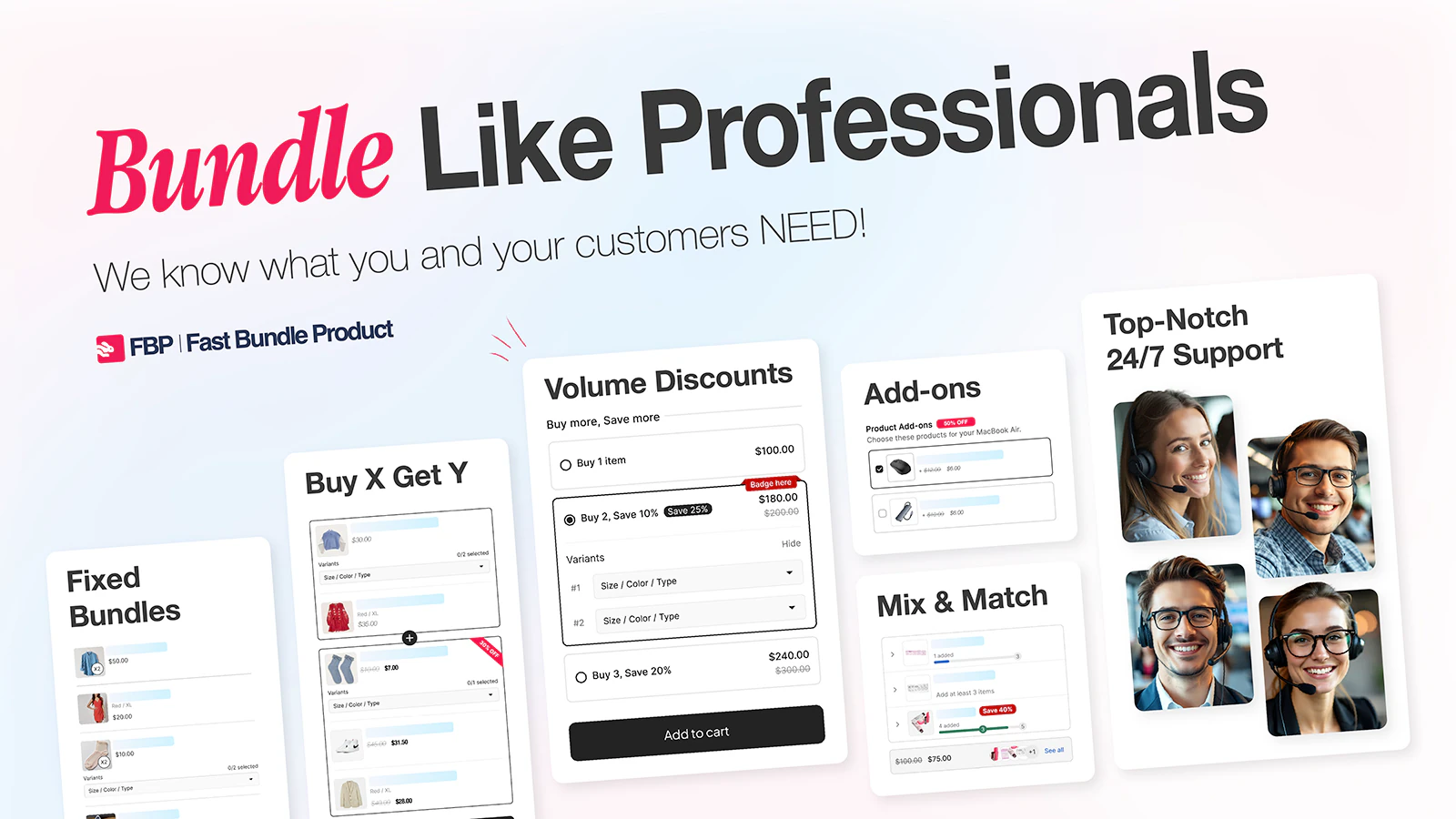
Key Features
Pricing
Use this app if you need an all-in-one Shopify product bundling tool with AI upsells, customizable logic, and native Shopify integration.
That’s a wrap on the best Shopify product bundling strategies and tools to boost your store’s revenue. I’ve shown you how to turn your products into smart offers that boost AOV, move inventory, and give customers a better deal.
If you’re just getting started or want one tool that can handle everything from BOGO deals to advanced bundle logic, I highly recommend giving BOGOS.io a try. It’s flexible, easy to use, and plays nicely with Shopify’s checkout. Hope it helps!
Start small. Test one bundle type (e.g., Mix & Match or Volume Discount) with a bestselling product and track performance.
It works for basic use cases, but it doesn't support complex logic, often struggles with inventory syncing, and can't handle variant-based combos. Most growing stores switch to a dedicated bundling app pretty quickly.
Start with Frequently Bought Together or Fixed-Price Bundles. They’re easy to implement and don’t require a large product range.